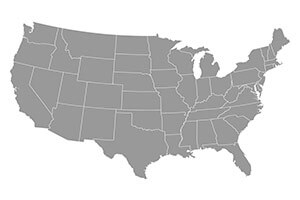
United States
Honey production is down in a large part of the United States due to severe weather events. Large honey packers had held off buying honey and are now scrambling to find sufficient supplies. This increased demand is driving up prices across the board. Hurricane Harvey and Hurricane Irma impacted two major beekeeping regions, Texas and Florida. These heavy rains may have disrupted the fall nectar flows beekeepers traditionally use to build up their colonies for their almond pollination contracts. Many counties impacted by the storms have been declared national disaster areas and federal relief is available to beekeepers who lost colonies due to the hurricanes. See the article Harvey & Irma’s Impact on Beekeepers in this issue for more information.
Northeast
After a very slow start, the Northeast is one of the few brighter spots for honey production this year. Beekeepers are reporting very good harvests. The cool weather and rain earlier in the year drove high swarming and poor honey production, but many reported good summer flows due to adequate moisture. Certain regional areas experienced drought like conditions for a longer time frame than others but overall the entire region has experienced idyllic weather conditions in the late summer. Areas with higher moisture levels created the resources for a prodigious honey flow with many usually late floral and nectar sources coming on early. With fall plants flowering sooner than expected, bees may have pollen shortages for rearing winter bees. For some this has necessitated the feeding of pollen substitute as well as sugar syrup, which is a situation rarely experienced in New England. In August the bees were working the legumes such as alsike clover (Trifolium hybridum), purple vetch (Vicia sativa), birds foot trefoil (Lotus corniculatus), alfalfa (Medicago sativa), Japanese Knotweed (Fallopia japonica), and clovers such as white sweet clover (Melilotus alba) and yellow sweet clover (Melilotus officinalis), all of which were in full bloom in late summer. Early harvested honey was reportedly some of the highest quality and lightest colored ever harvested. Harvested honey has been averaging 30-40 lbs. per colony in New England. Beekeepers have been busy concentrating on extracting honey.
Reportedly, some keepers lost hives due to a continuance of rain preventing bees from foraging, thus there were no surplus honey stores and nectar sources were not fully processed. The wet weather kept bees home bound, with negative impacts on comb drawing. Honey production slowed with honey supers not filling up, forcing some keepers to feed, particularly this year’s new hives.
Demand at all retail/wholesale outlets remained strong and honey sales remained firm, although Maine beekeepers reported a major slowdown in retail sales this summer. Current prices for retail 1lb bottled units were steady.
Mideast
The Mideast reported decreases of up to 50% below average in honey harvests. Many bees went hungry this summer and the fall flow is just a trickle in Virginia. Kentucky reported that the goldenrod flow is too light to sustain bees and beekeepers are having to feed. Other plants that were blooming are Joe Pye weed, ironweed, asters, morning glory, and mints. Due to this lack of a good, strong fall flow, the region reports fair to poor winter stores.
Demand for honey remains high and brisk sales ensure beekeepers have little stock on hand. In Virginia and West Virginia bees collected nectar from red and white clover, sumac, elderberry, joe pye weed, wildflowers, and basswood. Colonies appear to be in good health, though the summer drought experienced in Virginia reduced honey harvests and left bees hungry. Beekeepers are reporting fair winter stores and feeding interventions seem to be the norm this fall. High varroa levels continue to be a problem in the mideast, with average counts of 7 mites per 100 bees.
Southeast
Hurricane Irma strongly impacted Florida beekeepers, though the extent of damage and the impacts on the Brazilian Pepper flow are not yet fully know. Citrus and Gallberry harvests were reported down, with beekeepers reporting 10% and 40% less than normal harvests. There were few sources of food for bees, only scattered wildflowers such as Goldenrod and Spanish Needle, which led to supplemental feeding. Many migratory beekeepers move colonies back to Florida to take advantage of the September Brazillian Pepper flow, which will most likely be negatively impacted by the heavy rains and storms experienced. This may impact colony strength of bees heading to almonds. Beekeepers may need to boost colony strength through extensive feeding, adding substantially to colony maintenance costs.
In Alabama beekeepers reported normal to slightly below normal honey harvests, primarily due to heavy rain. During July 2017, frequent rain kept everything wet in Alabama. That’s both good and bad for beekeeping. One could have supposed that the frequent rain would have encouraged nectar production, but frequent rain periods and afternoon thundershowers reduced nectar production and prevented bees from efficiently foraging. Indeed, some colony starvation was reported by beekeepers. During this wet period, beekeepers had queen failure issues probably due to reduced times that unmated queens could take mating flights. When August arrived and goldenrod and fall asters bloomed, the general trend continued. It appears that the various weather events during spring and early summer affected soil moisture and growing conditions in the later season. The nectar flow sources in general have been more “bunched.” This resulted in a good nectar flow for a short while. As is so typical, some beekeepers were happy with the August flow while others got very little from their bees. Honey prices seem to be holding steady.
Southwest
The Southwest has been struggling with a dearth and then the aftereffects of Hurricane Harvey. Honey crops were reported …


